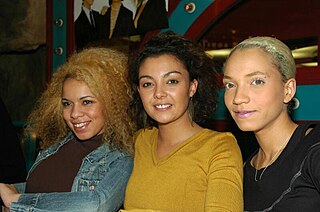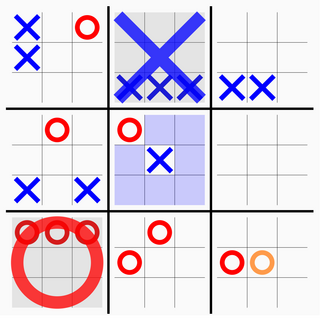Katakuti (lit. 'tic-tac-toe') may refer to:

Tic-tac-toe, noughts and crosses, or Xs and Os is a paper-and-pencil game for two players who take turns marking the spaces in a three-by-three grid with X or O. The player who succeeds in placing three of their marks in a horizontal, vertical, or diagonal row is the winner. It is a solved game, with a forced draw assuming best play from both players.
Oxo or OXO may refer to:
TTT or Triple T may stand for:

3D tic-tac-toe, also known by the trade name Qubic, is an abstract strategy board game, generally for two players. It is similar in concept to traditional tic-tac-toe but is played in a cubical array of cells, usually 4×4×4. Players take turns placing their markers in blank cells in the array. The first player to achieve four of their own markers in a row wins. The winning row can be horizontal, vertical, or diagonal on a single board as in regular tic-tac-toe, or vertically in a column, or a diagonal line through four boards.
A toe is a digit of the foot of a human or animal.
Tick tock, tic toc, Tik Tok and other variants may refer to:

Tic Tac Toe were a German girl group formed in 1995, performing pop-rap music. Their first two albums, Tic Tac Toe and Klappe die 2te, were million-selling commercial successes and spawned major hits "Ich find' dich scheiße", "Verpiss' dich" and "Warum?". The band found biggest popularity in German speaking countries, the Netherlands and Eastern Europe. Due to numerous scandals and personal issues between the group members, Tic Tac Toe split in 2001. The band had a successful but short-lived comeback in 2005 with the hit single "Spiegel", but ultimately disbanded in 2007.
Tic-Tac-Toe barb is a common name used for two separate species of barbs:

Tic-Tac-Terror is the 74th title of the Hardy Boys Mystery Stories, written by Franklin W. Dixon. It was published by Wanderer Books in 1982.
MAYA-II is a DNA computer, based on DNA Stem Loop Controllers, developed by scientists at Columbia University and the University of New Mexico and created in 2006.

Quantum tic-tac-toe is a "quantum generalization" of tic-tac-toe in which the players' moves are "superpositions" of plays in the classical game. The game was invented by Allan Goff of Novatia Labs, who describes it as "a way of introducing quantum physics without mathematics", and offering "a conceptual foundation for understanding the meaning of quantum mechanics".
Harary's generalized tic-tac-toe or animal tic-tac-toe is a generalization of the game tic-tac-toe, defining the game as a race to complete a particular polyomino on a square grid of varying size, rather than being limited to "in a row" constructions. It was devised by Frank Harary in March 1977, and is a broader definition than that of an m,n,k-game.

"Warum?" is a song by German female pop-rap group Tic Tac Toe. The song was written by Thorsten Börger and tells about a close friend of the group members, Melanie, who had developed an addiction to drugs and died as a result of overdose. "Warum?" was released as the lead single from their second album, Klappe die 2te (1997), on 24 February 1997 and was met with commercial success, reaching number one in Germany, Austria, and Switzerland as well as number four in the Netherlands. The single sold 700,000 copies in less than two months and remains Tic Tac Toe's biggest hit.
Tic Tac is a brand of small, hard candy.
X's and O's, Exes and Ohs, Ex's and Oh's, and other variants in spelling of that phrase may refer to:
Tic Tac Toe may refer to:
Noughts & Crosses is an alternative name for the game Tic-tac-toe

Ultimate tic-tac-toe is a board game composed of nine tic-tac-toe boards arranged in a 3 × 3 grid. Players take turns playing on the smaller tic-tac-toe boards until one of them wins on the larger board. Compared to traditional tic-tac-toe, strategy in this game is conceptually more difficult and has proven more challenging for computers.

Tic-tac-toe is an instance of an m,n,k-game, where two players alternate taking turns on an m×n board until one of them gets k in a row. Harary's generalized tic-tac-toe is an even broader generalization. The game can also be generalized as a nd game. The game can be generalised even further from the above variants by playing on an arbitrary hypergraph where rows are hyperedges and cells are vertices.
A nd game (or nk game) is a generalization of the combinatorial game tic-tac-toe to higher dimensions. It is a game played on a nd hypercube with 2 players. If one player creates a line of length n of their symbol (X or O) they win the game. However, if all nd spaces are filled then the game is a draw. Tic-tac-toe is the game where n equals 3 and d equals 2 (3, 2). Qubic is the (4, 3) game. The (n > 0, 0) or (1, 1) games are trivially won by the first player as there is only one space (n0 = 1 and 11 = 1). A game with d = 1 and n > 1 cannot be won if both players are playing well as an opponent's piece will block the one-dimensional line.